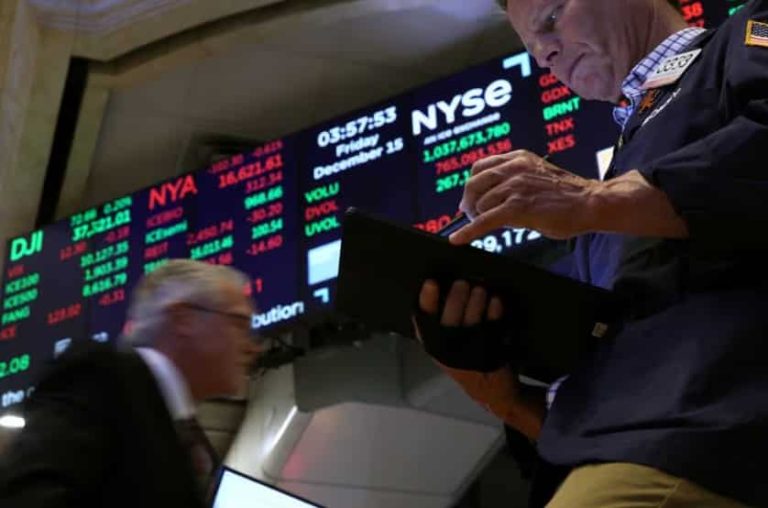U.S. stocks gained ground Monday as market participants analyzed growing expectations for interest rate cuts from the Federal Reserve in the coming year and awaited a week of crucial economic data.
A broad but modest rally propelled the S&P 500 and Nasdaq to solid gains, while the Dow finished flat.
“Markets are heading toward a Fed that will start cutting interest rates next year,” said Tom Hainlin, national investment strategist at US Bank Wealth Management in Minneapolis. « The data, whether it’s inflation, consumer spending or the job market, doesn’t deteriorate too quickly or get too hot, so the Goldilocks scenario continues to play out. realize. »
Wall Street continues to build on seven straight weeks of gains, the S&P 500’s longest weekly winning streak since 2017.
The S&P 500 is now about 1.2% off its all-time closing high, amid growing optimism about policy rate cuts in 2024, a fervor that Fed policymakers sought to rein in on Monday.
Chicago Fed President Austan Goolsbee warned that the central bank was not committed to cutting rates in the near future, while Cleveland Fed President Loretta Mester said markets Financial institutions had taken “a little lead” over the central bank with regard to the timing and scale of the measure. interest rate cuts.
Even so, financial markets have priced in a 63.4 percent chance that the central bank will lower its target federal funds rate by 25 basis points at its March monetary policy meeting, according to the CME’s FedWatch tool.
“There’s still a disconnect between investors predicting five to six cuts next year and the Fed’s scores pointing to three,” Hainlin added. “Markets continue to lead the Fed and that seems to imply that the number of cuts is fewer, just that there will be cuts.”
Later in the week, the Commerce Department is expected to release its third and final third-quarter GDP report on Thursday, which will be followed on Friday by its detailed Personal Consumption Expenditures (PCE) report, which will cover income growth, the consumption. spending and, above all, inflation.
The Dow Jones Industrial Average was flat at 37,306.02, the S&P 500 gained 21.37 points, or 0.45 percent, to 4,740.56 and the Nasdaq Composite added 90.89 points, or 0. 61 percent, to 14,904.81.
Among the 11 major S&P 500 sectors, communications services gained the most, with real estate and utilities ending the session in the red.
Increasing attacks by militant groups on ships in the Red Sea have driven up crude prices due to supply problems, boosting energy stocks, which have been largely left behind by the recent rally.
S&P 500 energy stocks added 0.8 percent.
United States Steel jumped 26.1 percent to its highest level in more than 12 years after Japan’s Nippon Steel said it would buy the steelmaker in a $14.9 billion deal , debt included.
Apple fell 0.9 percent as China’s ban on foreign-made iPhones and other gadgets gathered pace.
VF Corp fell 7.8 percent after announcing it was investigating « unauthorized » activity on its IT systems, which disrupted some of its operations, including the ability to fulfill orders at its site. e-commerce.
Advancing issues outnumbered declining ones on the NYSE by a ratio of 1.12 to 1; on the Nasdaq, a ratio of 1.15 to 1 favored the declines.
The S&P 500 posted 31 new 52-week highs and 2 new lows; The Nasdaq Composite recorded 132 new highs and 107 new lows.
Volume on U.S. exchanges totaled 11.75 billion shares, compared to an average of 11.88 billion for the entire session over the past 20 trading days.



